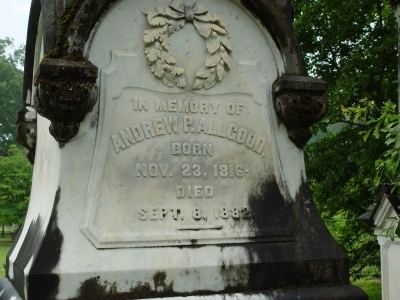Name Andrew Allgood | Died 1882 | |
 | ||
Occupation

The town of Trion, Georgia, which is in Chattooga County, Georgia got its name from the factory built there. This mill was the first cotton mill in northwestern Georgia, and Trion was the first mill town. On October 12, 1845, the mill was incorporated and named by its three founders for their partnership. Andrew Allgood, Spencer Marsh, and Col. W. K Briers built the mill. Since the mill and the town had a trio of founders, both were given the name Trion. In 1858 Allgood's mill was used as a hospital for the community during an outbreak of typhoid fever. During the War Between the States, Allgood employees provided clothing for the confederate soldiers.
On April 10, 1875, Andrew Perry Allgood watched fire destroy the mill into which he had invested most of his adult life; however, Allgood was not a man to let arson, war, or even Union General William Tecumseh Sherman rob him of his life’s work. In less than six months, a new building had been constructed, and the mill was back in operation.
A.P. Allgood, who was born in South Carolina, moved to La Fayette, Georgia, in 1836 and opened a general merchandise store. Allgood became friends with Spencer Stewart Marsh, also a La Fayette merchant, and married Marsh’s oldest daughter, Mary Ann. Allgood became a judge of the Inferior Court of Chattooga County and served for most of his remaining years after moving with his wife to the Trion area. He was widely respected as a community leader and early industrialist in Georgia.
During this time time, cotton products were very expensive in the northwest Georgia area. The nearest cotton mill was 100 miles away in Roswell, Georgia. Marsh and Allgood believed that a textile mill in the La Fayette area would greatly reduce the price of cotton goods and made plans to build such a mill. Three things were needed inexpensive land, plenty of timber for construction, and an abundant water supply to run the mill. All three were found on the Chattooga River about 10 miles south of La Fayette. The Trion Mill, as it was called, was founded in 1845, and became the nucleus for the town of Trion, Georgia. Construction of the mill took several years. It went into operation in 1847 with 600 spindles and 40 employees. Later that year, four spinning frames were added for the production of cloth.
During General Sherman’s march to the sea in 1864, the cotton mills at Roswell and Sweetwater Creek were burned, the workers charged with treason, herded into railroad cars, and sent north. Many of these workers, mostly young women, were never able to return to their homes in Georgia.
Even though his mill was manufacturing cloth for the Confederate Army, Allgood saved his mill and his workers by convincing General Sherman that he was a Union man. Sherman ordered that the Trion Mill be closed but left a guard to protect it. The plant was closed from May of 1864 to May of 1865, but went back into production soon after the close of the War.
Many Confederates and Confederate sympathizers were outraged when they learned that Allgood had declared himself a Union man, and they vowed to get revenge. One such person was the Confederate guerrilla, John Gatewood. Allgood’s encounter with Gatewood is told in Robert S. Baker’s Chattooga County, the Story of a County and Its People. “Gatewood was the most notorious of the Confederate guerrillas operating in the Northwest Georgia. Sometime during the War, probably during the latter part, after Allgood had declared himself to be a Union sympathizer, Gatewood and some of his gang came to the Allgood home and demanded money and other valuables. A. P. stated that he had no money or valuables in the house, but Gatewood refused to believe him. The gang took Allgood from his home and marched him to a tree where they threw a rope over a limb and placed a noose around Allgood’s neck. However, the noose was put around A. P.’s long, thick beard as well as around his neck. Evidently, the beard prevented the rope from doing its intended work for immediately after Gatewood and his men rode away, the victim was able to remove the noose and hurry home.” This encounter with Gatewood was not the last time Allgood would pay for being a Union sympathizer. The burning of his mill in 1875 was ruled to be the work of arsonists. Even though the mill was back in operation in a very short time, this event and the death of his fifteen year old daughter in 1878 were tragedies from which he never fully recovered. His health began to decline, and he died on September 8, 1882. Andrew Perry Allgood is buried in the La Fayette cemetery. His marker is one of the tallest in the cemetery and therefore, is easy to find.
The significance of Allgood's industrial career in founding the Trion Mill has been tremendous in that this same mill survives today as a major source of employment in Northwest Georgia and one of the few constantly operating textile mills in the United States. It has been owned by only four families in its history and is still producing denim, a rarity in the United States in the 21st Century.
Sources:
1. Baker, Robert S. Chattooga County, A Story of a County and Its People. Roswell, Georgia: WH Wolfe Associates, 1988.
2. O’Brian, Sean Michael. Mountain Partisans. Westport, Ct: Praeger, 1999.
3. http://georgiainfo.galileo.usg.edu/topics/people/article/business-leaders/allgood-andrew-perry (data on January 7, 2017) 4. http://www.georgiaencyclopedia.org/articles/business-economy/textile-industry. The New Georgia Encyclopedia. (data on January 13, 2017)
Gratitude to Connie Bomar Forester of the Walker County Historical Society for most of the research and writing for this article in September of 2016. David P. Boyle, President of Walker County Historical Society. January 7, 2016.
